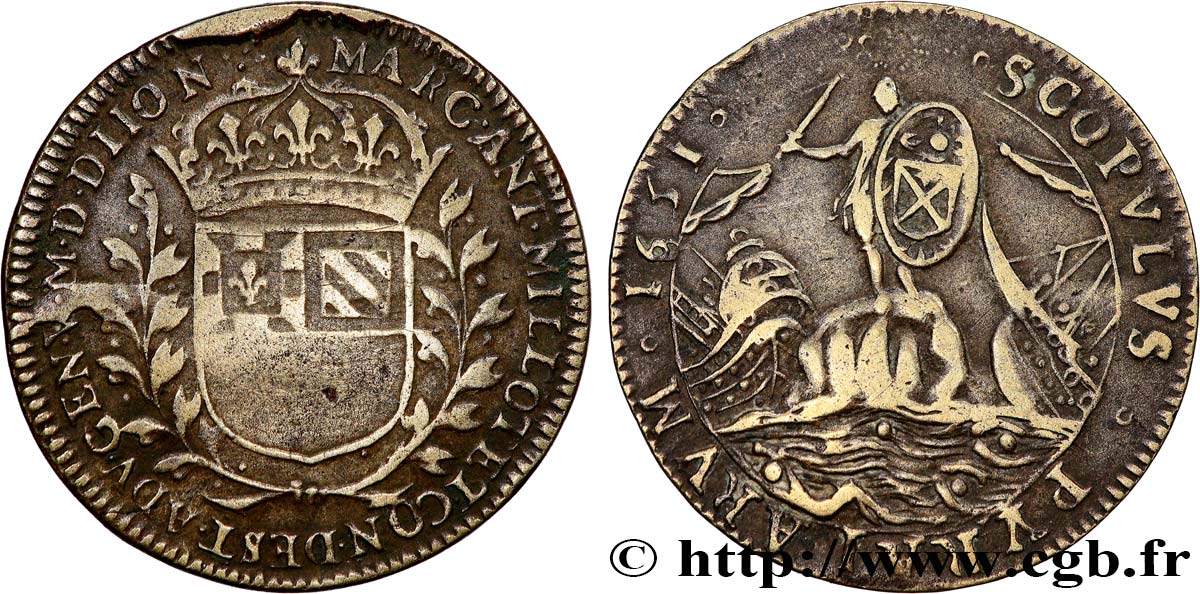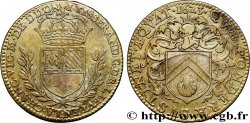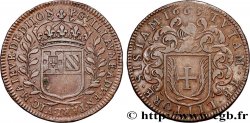fjt_771503 - DIJON (MAIRES DE ... et divers) Marc-Antoine Millotet 1651
недоступный.
Товар уже продан в нашем интернет-магазине (2024)
Цена: : 45.00 €
Товар уже продан в нашем интернет-магазине (2024)
Цена: : 45.00 €
Тип Marc-Antoine Millotet
Дата: 1651
Металл: brass
Диаметр: 27 mm
Ориентация осей монеты: 6 h.
Вес: 5,80 g.
Век: Lisse
Редкость: R1
Комментарии о состоянии
Présence de faiblesses de frappe et de traces d’usure
Ссылки в каталоге: :
Происхождение:
Jeton provenant de la Collection MARINECHE
Лицевая сторона
Аверс: легенда: MARC. ANT. MILLOTET. CON. DEST. ADV. GEN. V. M. D. DIION *.
Аверс: описание: Armes de Dijon dans une couronne de laurier.
Обратная сторона
Реверс: легенда: SCOPVLVS. PYRATARVM. 1651. (FLEURON).
Реверс: Описание: Marc-Antoine Millotet debout sur un rocher au milieu des flots contre lesquels se brisent des vaisseaux chargés d’hommes.
Комментарий
Marc-Antoine Millotet, premier avocat général au Parlement, fut élu maire le 21 juin 1650. Il porte d’azur au sautoir d’or accompagné en chef d’une croix raccourcie d’argent. *
Il raconte :
Lorsque j'entrai dans la magistrature, j'ôtai tous les moyens de prendre, outre que j'avais poursuivi force partisans, dont j'en avais fait pendre en effigie pour avoir falsifié les rôles du conseil. C'est pourquoi mes premiers jetons portaient cette devise: Scopulus piratorum; car d'un côté c'étaient les armes de la ville et mon nom qui les entourait, et de l'autre j'étais représenté sur un rocher au milieu des flots contre lequel se brisaient des vaisseaux chargés d'hommes. J'avais l'épée en une main et le bouclier dans l'autre où mes armes étaient gravées, et autour du jeton était ma devise pareille à celle de Pompée qui, après la défaite des Pirates, fut ainsi surnommé, comme il se voit dans Pétronne". Extrait d'un manuscrit intitulé "Mémoires servant à l'histoire des choses qui se sont passées en Bourgogne pendant la Ire et la 2e guerre civile en 1650, au tems de la détention des princes et depuis leur liberté, par M.A. Millotet. Dans la salle de l'ancien hôtel de ville, une inscription célèbre l'activité de M.A. Millotet: "Marc-Antoine Millotet, maire, par sa courageuse fermeté, maintint, en 1648, à Dijon, l'autorité du Roi pendant les guerres de la Fronde"
Les maires de Dijon
Dès l’époque de la naissance de la féodalité, la ville de Dijon possédait un maire et en général vingt magistrats municipaux, ou échevins. Ces magistrats sont confirmés en 1187, lorsqu’une charte de commune est accordée par le duc Hugues III. En 1192, pour la première fois, le maire dijonnais est élu.
A la fin du XIIIe siècle, ce maire prend le titre de vicomte maïeur, confirmé en 1477-1479 par Louis XI, qu’il gardera jusqu’en 1789. Depuis la fin du XVe siècle (1491), la charge de vicomte maïeur est anoblissante ainsi que celle d’échevin à compter du XVIe siècle. Le vicomte maïeur avait le droit de haute, moyenne et basse justice, le droit de scel et de visite. Les clefs de la ville lui sont confiées et il dirige les archers ainsi que les compagnies des sept quartiers, cette fonction militaire étant importante jusqu’au XVIIe siècle.
Fonction élective, le vicomte maïeur est élu par les habitants, ni mendiants, ni étrangers, qui payent la taille, en général la veille de la Saint-Jean. Cette élection a lieu sur le parvis de l'église saint Philibert. A partir de 1669, il est permis au maire de porter "une robe longue de satin plein, de couleur violet, doublée de satin rouge cramoisi, comme le prévôt des marchands de Lyon, avec chaperon de même étoffe et couleur bordée d’hermine" afin de se distinguer des habitants.
En 1692, la fonction de vicomte maïeur est transformée en office héréditaire tandis que l’élection n’est plus alors qu’une confirmation du choix royal fait par le gouverneur au nom du roi.
Voir leur liste complète à http://fr.wikipedia.org/wiki/Liste_des_maires_de_Dijon.
Il raconte :
Lorsque j'entrai dans la magistrature, j'ôtai tous les moyens de prendre, outre que j'avais poursuivi force partisans, dont j'en avais fait pendre en effigie pour avoir falsifié les rôles du conseil. C'est pourquoi mes premiers jetons portaient cette devise: Scopulus piratorum; car d'un côté c'étaient les armes de la ville et mon nom qui les entourait, et de l'autre j'étais représenté sur un rocher au milieu des flots contre lequel se brisaient des vaisseaux chargés d'hommes. J'avais l'épée en une main et le bouclier dans l'autre où mes armes étaient gravées, et autour du jeton était ma devise pareille à celle de Pompée qui, après la défaite des Pirates, fut ainsi surnommé, comme il se voit dans Pétronne". Extrait d'un manuscrit intitulé "Mémoires servant à l'histoire des choses qui se sont passées en Bourgogne pendant la Ire et la 2e guerre civile en 1650, au tems de la détention des princes et depuis leur liberté, par M.A. Millotet. Dans la salle de l'ancien hôtel de ville, une inscription célèbre l'activité de M.A. Millotet: "Marc-Antoine Millotet, maire, par sa courageuse fermeté, maintint, en 1648, à Dijon, l'autorité du Roi pendant les guerres de la Fronde"
Les maires de Dijon
Dès l’époque de la naissance de la féodalité, la ville de Dijon possédait un maire et en général vingt magistrats municipaux, ou échevins. Ces magistrats sont confirmés en 1187, lorsqu’une charte de commune est accordée par le duc Hugues III. En 1192, pour la première fois, le maire dijonnais est élu.
A la fin du XIIIe siècle, ce maire prend le titre de vicomte maïeur, confirmé en 1477-1479 par Louis XI, qu’il gardera jusqu’en 1789. Depuis la fin du XVe siècle (1491), la charge de vicomte maïeur est anoblissante ainsi que celle d’échevin à compter du XVIe siècle. Le vicomte maïeur avait le droit de haute, moyenne et basse justice, le droit de scel et de visite. Les clefs de la ville lui sont confiées et il dirige les archers ainsi que les compagnies des sept quartiers, cette fonction militaire étant importante jusqu’au XVIIe siècle.
Fonction élective, le vicomte maïeur est élu par les habitants, ni mendiants, ni étrangers, qui payent la taille, en général la veille de la Saint-Jean. Cette élection a lieu sur le parvis de l'église saint Philibert. A partir de 1669, il est permis au maire de porter "une robe longue de satin plein, de couleur violet, doublée de satin rouge cramoisi, comme le prévôt des marchands de Lyon, avec chaperon de même étoffe et couleur bordée d’hermine" afin de se distinguer des habitants.
En 1692, la fonction de vicomte maïeur est transformée en office héréditaire tandis que l’élection n’est plus alors qu’une confirmation du choix royal fait par le gouverneur au nom du roi.
Voir leur liste complète à http://fr.wikipedia.org/wiki/Liste_des_maires_de_Dijon.








 Cообщить об ошибке
Cообщить об ошибке Распечатать страницу
Распечатать страницу Отправить мой выбор
Отправить мой выбор Задать вопрос
Задать вопрос Consign / sell
Consign / sell
 Информация
Информация









